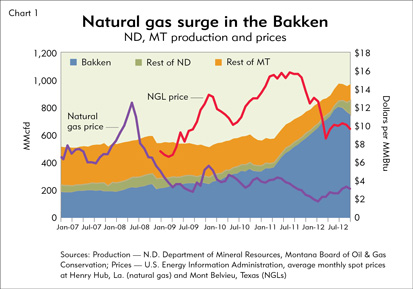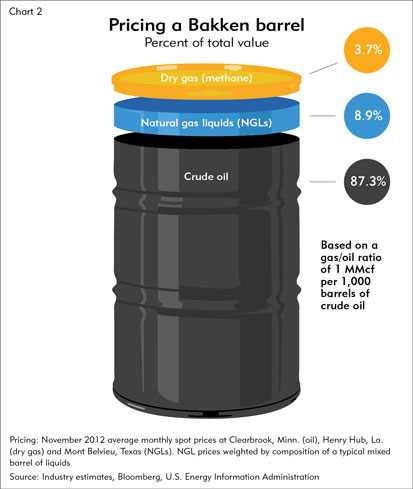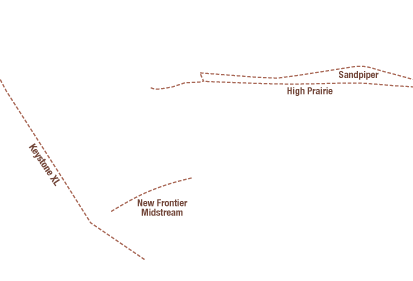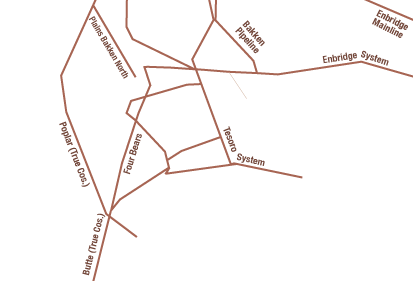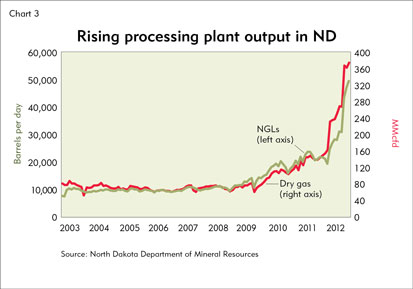The Quick Take: In North Dakota, about 30 percent of natural gas emitted from oil wells is flared because it’s less valuable than crude. But investment in the infrastructure necessary to process and transport gas is occurring, albeit at a slower pace than oil-related development. Moving gas from wellhead to market is more complex than crude oil transportation. Unlike oil, Bakken gas must be processed to separate out natural gas liquids and make them fit to ship. And dry gas (methane) and NGLs require different modes of transport. Because of relatively higher prices for NGLs, recent gas infrastructure development in the Bakken has focused to a greater extent on producing and transporting NGLs.
In North Dakota, oil is king. That becomes obvious at night, when the western part of the state lights up like a terrestrial birthday cake as oil wells across the Bakken region flare off natural gas that is a byproduct of oil pumping. So much gas is burning that satellite images of the region at night show a city-like constellation of lights, surrounded by blackness.
The associated gas that comes up with the crude is an economic afterthought for producers; despite the fact that gas accounts for one-quarter of the energy output of a typical Bakken well, it contributes only about 13 percent of the well’s value. In North Dakota, about 30 percent of natural gas emitted from oil wells is flared, according to the state Department of Mineral Resources (DMR).
Many developers of oil wells are content to flare gas—essentially wasting it—for several reasons. The first is that they are allowed to, for a while. A second is that collecting it requires significant investment in gathering pipelines and other infrastructure to capture gas and get it to market. And a third is the fact that such investments aren’t as lucrative as oil-related spending; gas prices have fallen sharply due to increased shale gas production across the country.
Nevertheless, the potential economic opportunity has lit a slow investment burn under the gas market in the Bakken. The infrastructure necessary to process and transport gas is getting built—just not at the frenetic pace of oil-related development (see “Busting bottlenecks in the Bakken”). More new wells are getting connected to processing plants, and since 2008 gas-processing capacity in North Dakota has more than doubled, prompting increased investment in gas transmission pipelines.
Part of the impetus for gas development is state law: In North Dakota and Montana, well operators who flare gas for months face restrictions on oil production. But the main reason more Bakken gas is being captured, processed and shipped is that it makes financial sense to do so. Bakken gas is more valuable than gas from other parts of the country because it contains a high proportion of natural gas liquids (NGLs)—so-called “wet” hydrocarbons such as propane and butane that command higher prices than methane (or “dry”) gas burned by power plants and household furnaces.
Natural gas may be produced simultaneously with oil in the Bakken, but the physics and economics of moving gas from wellhead to market are markedly different. Unlike crude, Bakken gas must be processed to make it fit to ship. And both raw and processed gas requires pipelines for transport, while NGLs can be moved by pipeline, rail or truck. Because of relatively higher prices for NGLs, recent gas infrastructure development in the Bakken has focused to a greater extent on producing and conveying liquids.
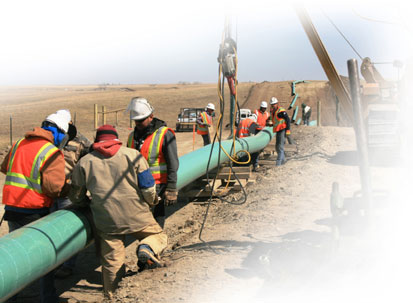
Construction crews under contract for WBI Energy lay a natural gas pipeline near Williston, N.D. Photo courtesy of WBI Energy.
Bakken oil—it’s a gas
North Dakota and Montana are not leading producers of natural gas (see back page map); federal production statistics lump them into the “other states” category, well behind major producers such as Texas, Alaska and Louisiana. In 2011, North Dakota and Montana accounted for less than 1 percent of U.S. gas production.
But gross gas production—the volume of gas coming out of the ground, including gas that’s flared—keeps marching upward in the western part of the district, along with that of oil. Oil and gas fields in North Dakota and Montana produced over 900 million cubic feet per day (MMcfd) last November, with most production increases over the past two years occurring in North Dakota and within the Bakken region, where gas and oil production go hand in hand (see Chart 1).
At the same time, dry gas prices have fallen because of rising shale bed production not just in the Bakken, but also in other areas of the country, such as southern Texas and parts of New York, Ohio and Pennsylvania. Nationwide, gas production increased 21 percent from 2007 to 2012, according to the U.S. Energy Information Administration. Natural gas is sold on the basis of its heating value, measured in British thermal units (Btu). Last December, the U.S. spot price of natural gas was $3.34 per million Btu (MMBtu), less than half of the annual average price in 2008—and on a Btu basis, less than one-quarter the price of crude oil.
In areas such as north-central Montana that produce primarily methane—gas extracted from shallow wells or coal seams rather than oil shale—low gas prices have virtually halted exploration and drilling, reducing output. “The price is less than the finding cost,” explained Tom Richmond, an administrator with the Montana Board of Oil and Gas.
But countervailing market forces are at work in the Bakken, where the high NGL content of “wet” gas coming out of oil wells gives energy companies an incentive to capture and process it. Liquid hydrocarbons derived from gas not only provide energy, but also have myriad industrial applications. Gas liquids include propane, commonly used in outdoor grills and space heating; ethane, a vital ingredient of ethylene for making plastics; and butane, a blending agent in gasoline.
Such applications make NGLs much more valuable than dry gas. “It’s the natural gas liquids that are making the gathering and processing of the gas economic at all,” said Lynn Helms, director of the North Dakota DMR.
Liquids account for more than two-thirds of the value of Bakken gas (see “Pricing a Bakken barrel”), and as Chart 1 shows, NGL prices have tracked well above dry gas prices over the past three years. Prices for NGLs used in oil refining, such as butane and natural gasoline (pentane), were much higher, though all types of NGLs had depreciated since 2011 because of surging production from wet-gas plays such as the Bakken and the Eagle Ford in Texas.
Another spur to gas development is state laws intended to cut air emissions and waste. In North Dakota, producers who flare for more than 60 days are required to cut back oil production, and after flaring for a year, they must either pay royalties on the torched gas or shut down the well. “You can’t burn this gas in the atmosphere forever,” said Rodney Wren, president of New Frontier Midstream, a Texas-based developer of gas infrastructure in the Bakken region. “Sooner or later, you’re going to have to do something with it, or you’re not going to be able to produce your oil.”
However, even after a year, many wells continue to flare gas; exemptions giving operators more time to connect to pipelines and market their gas are routinely granted by regulators.
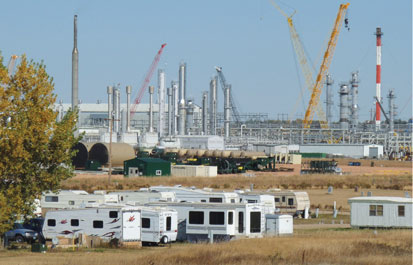
Hess is expanding and upgrading its gas processing plant in Tioga, N.D. Photo by Phil Davies.
The processing boom
The value of NGLs, together with flaring regulations, is driving construction of new processing plants to separate liquids from dry gas and of pipelines and other facilities to move both commodities to market.
Over the past five years, gas-processing firms have built six new plants and expanded existing facilities in North Dakota, increasing processing capacity in the Bakken region from less than 400 MMcfd to about 925 MMcfd. The plants separate NGLs from dry gas so that they can be transported in liquid form. Some plants produce a blend of NGLs to be fractionated (separated out) later at facilities outside the region; others strip out individual liquids such as propane and ethane to be marketed separately.
One of the biggest players in Bakken gas is Oneok Partners of Tulsa, Okla., a “full-service midstream provider” that stores, processes and transports gas, charging producers a portion of the proceeds from gas sales. In January, Oneok announced up to $500 million in Bakken capital projects through 2015—spending that comes on top of about $2 billion previously invested in the region.
The company operates four processing plants in western North Dakota, including a $300 million, 100 MMcfd plant west of Williston that went into service last fall. Another 100 MMcfd plant is nearing completion near Williston, and a sixth is slated to come online outside Watford City in 2014. “We started ahead of the game before the [oil and gas] boom, and these projects just build upon our base,” said Oneok spokesman Brad Borror.
New York-based Hess has processed gas since the 1950s at its large plant in Tioga, N.D., and is one of the state’s biggest propane suppliers. A $500 million expansion project will more than double capacity to 250 MMcfd by year’s end, making the Hess complex the largest gas-processing facility in the state. As part of the expansion, Hess is upgrading its equipment to capture ethane from raw gas. Ethane makes up the largest proportion of wet gas by volume, but extracting it requires deep refrigeration, an expensive and energy-intensive process.
More new plants and expansions are on the drawing board. New Frontier Midstream has proposed building advanced processing plants near Dickinson, N.D., and Sidney, Mont., capable of capturing virtually all NGLs. The two plants will have a combined capacity of 50 MMcfd and, together with gathering systems, cost about $130 million to develop, Wren said. A total of 300 MMcfd of new processing capacity is slated to come online in the region by the end of next year.
Map


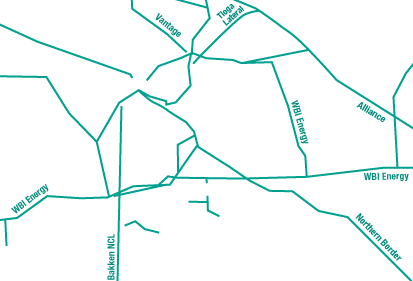





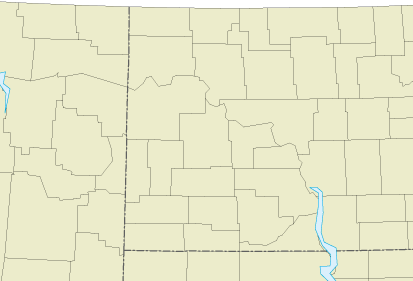
Show:
Burgeoning processing capacity has increased production of both NGLs and dry, residual gas (see Chart 3). The output of North Dakota plants, including two facilities just outside the Bakken region, rose steeply from 2010 to 2012. Propane and butane contained in NGL mixes accounted for most of production.
Fluid movement
But as processing capacity has ramped up, expansion of gas pipelines has failed to keep pace. In North Dakota, one-third or more of processing capacity goes unused, because vast volumes of gas are burned off at wellheads, never reaching a plant via pipeline. The state has a “severe shortage” of gathering lines to transport gas to processing plants, said Justin Kringstad, director of the North Dakota Pipeline Authority (NDPA). (Flaring is less prevalent in Montana because the slower pace of well drilling gives producers more time to connect to gathering networks.)
“The good news is that over time...the number of wells getting connected is increasing” as processors extend their gathering networks into oilfields, Kringstad said. Over the past 18 months, the percentage of North Dakota gas that is flared has fallen from 36 percent to less than 30 percent, according to the state DMR. Also, the number of wells in the state producing gas for sale—indicating they’re connected to a processor via pipeline—rose about 45 percent between 2011 and 2012.
The rising output of processing plants is also driving demand for transmission infrastructure, especially facilities geared toward moving NGLs, to deliver processed gas to markets. Liquids can be transported by rail, and for years Bakken NGLs have been shipped in high-pressure tank cars to customers in the region (the Tesoro refinery in Mandan, N.D., uses butane as a gasoline additive) or distant fractionating plants.
Oneok operates an NGL rail facility south of Sidney linked by pipelines to its processing plants, and Hess and Texas-based Plains All American Pipeline also ship NGLs by rail. Some liquids are trucked to rail terminals from small field units that perform basic processing at the wellhead.
But as is the case for crude oil, pipelines offer a more efficient route to market for NGLs. Over the past two years, processors and pipeline companies have invested heavily in pipeline projects designed to transport NGLs swiftly and cheaply.
Oneok is spending half a billion dollars on the Bakken NGL Pipeline, the first pipeline in the region dedicated to natural gas liquids. Scheduled to go into service this spring, the pipeline will provide an outlet for Oneok’s own processing plants in the region, carrying 60,000 barrels of liquids daily for ultimate delivery to fractionating plants in central Kansas that supply much of the nation’s midsection. The company plans to spend another $100 million to more than double the pipeline’s capacity in 2014.
Alliance Pipeline, a Canadian firm, is capitalizing on NGL development in the Bakken by transporting liquids in gaseous form. The company’s main pipeline through North Dakota carries unprocessed wet gas from western Canada to a fractionating plant near Chicago. The Tioga Lateral Pipeline, a new $168 million, 79-mile line slated for completion this summer, will collect gas containing NGLs from Hess’s processing plant and pump it into this mainline.
A second $240 million pipeline scheduled to go online this fall will carry liquid ethane from the Hess plant north to a petrochemical facility in Alberta, Canada. (For more detail on gas transportation projects in the Bakken, see the table.)
Getting in the flow
Major pipeline projects in the Bakken region
Pipelines operating or under construction*
| Project name, owner/developer, and description | Capacity | Cost | In Service |
|---|---|---|---|
Bakken Pipeline (show details) |
145,000 bopd | $180 million | 1st quarter 2013 |
Four Bears Pipeline (show details) |
110,000 bopd |
Undisclosed | 2011 |
Plains Bakken North Pipeline (show details) |
50,000 bopd | $60 million | Mid-2013 |
Bakken NGL Pipeline (show details) |
60,000 bopd | $500 million | 1st quarter 2013 |
BakkenLink Pipeline (show details) |
65,000 bopd | $127 million | 4th quarter 2013 |
Tioga Lateral Pipeline (show details) |
126 MMcfd | $168 million | 2nd quarter 2013 |
Vantage Pipeline (show details) |
40,000-60,000 bopd | $240 million | 3rd quarter 2013 |
*Projects undertaken since 2011.
Sources: North Dakota Pipeline Authority; oil and gas industry reports
Proposed pipelines
| Project name, owner/developer, and description | Capacity | Cost | In Service |
|---|---|---|---|
Sandpiper Pipeline (show details) |
225,000-375,000 bopd | $2.5 billion | 2015 |
High Prairie Pipeline (show details) |
150,000 bopd | Undisclosed | 4th quarter 2013 |
Crude oil and NGL pipelines from Dickinson, N.D., to Baker, Mont. (show details) |
Undisclosed | Undisclosed | 4th quarter 2013 |
Keystone XL Pipeline (show details) |
100,000 bopd of Bakken crude; total capacity of 830,000 bopd | $5.3 billion | 2015 |
Sources: North Dakota Pipeline Authority; oil and gas industry reports
Major rail facilities operating or under construction*
| Project name, owner/developer, and description | Capacity | Cost | In Service |
|---|---|---|---|
Bakken Oil Express near Dickinson, N.D. (show details) |
100,000 bopd | Undisclosed | 2011 |
Manitou rail facility, Ross, N.D. (show details) |
65,000 bopd oil; 8,500 NGLs |
$40 million | 2011 |
COLT Hub, Epping, N.D. (show details) |
120,000 bopd | Undisclosed | 2nd quarter 2012 |
Van Hook Crude Terminal near New Town, N.D. (show details) |
35,000 bopd | Undisclosed | 1st quarter 2012 |
Musket crude oil rail terminal, Dore, N.D. (show details) |
60,000 bopd | Undisclosed | 2nd quarter 2012 |
Savage Bakken Petroleum Services Hub, Trenton, N.D. (show details) |
90,000 bopd | Undisclosed | 3rd quarter 2012 |
Hess rail yard Tioga, N.D. (show details) |
60,000 bopd | $50 million | 1st quarter 2012 |
BakkenLink rail hub, Fryburg, N.D. (show details) |
65,000 bopd | $40 million | 4th quarter 2012 |
Enbridge rail hub, Berthold, N.D. (show details) |
80,000 bopd | $160 million (both sites) | 1st quarter 2013 |
Global Basin Transload, Beulah, N.D. (show details) |
60,000 bopd | Undisclosed | First half 2012 |
Table lists most hubs built since 2011; information unavailable for some facilities.
Sources: North Dakota Pipeline Authority; railroad and energy industry reports
Low natural gas prices have discouraged massive investment in dry gas transmission—the fat pipelines that deliver methane to utilities, manufacturers and other buyers. But the vapor left after all or most of the NGLs are extracted at processing plants “has to go somewhere,” observed Borror of Oneok. “Only a certain amount can be absorbed by the local market. We rely on long-range transmission lines to take gas out of the region and bring it to the market.” Gas piped out of the Bakken goes to regional markets such as Billings, Mont., and Fargo, N.D., and beyond to Minneapolis-St. Paul and other Midwestern cities.
Instead of undertaking expensive new pipeline projects to accommodate increasing volumes of dry gas coming out of the Bakken, pipeline firms have mostly added capacity to their existing networks.
WBI Energy Transmission of Bismarck, N.D., owns 3,700 miles of gas pipelines spanning North Dakota and extending into South Dakota, Montana and Wyoming. Its transmission lines feed into the Northern Border Pipeline, a major route for Canadian gas headed to the Chicago area. Without putting a lot of new pipe in the ground, WBI Energy has quadrupled its transmission capacity in the Bakken since 2009, said Rob Johnson, the firm’s director of market services and system planning.
Most of the expansion came from improvements (such as higher gas compression) on existing long-haul lines, but the firm has also built small, local pipelines such as a 12-mile segment connecting a Oneok processing plant to the distribution network, completed last year. “We continue to work a number of projects for takeaway out of the Bakken, as well as projects within the Bakken,” Johnson said.
Room to grow
Gas infrastructure development in the Bakken is expected to accelerate as gas production swells along with oil output. An NDPA forecast based on likely oil-drilling scenarios predicts that gas production in western North Dakota and eastern Montana will exceed 1,500 MMcfd by 2018—double last fall’s production—and keep rising for another decade.
As more gathering pipeline is laid to wells and flaring diminishes, additional processing capacity will be necessary to prepare gas for transport and sale. Oneok is operating under that assumption; in January, the firm announced plans to build its seventh processing plant in the Bakken, a 100 MMcfd facility scheduled to go into service near Watford City in 2015.
In the near term, transportation capacity appears adequate to move Bakken gas, including NGLs, from processing plants to regional and national markets. The Bakken NGL Pipeline when completed will absorb the entire liquids output of Oneok’s existing and proposed processing plants. And just as rail hubs have become release valves for crude oil (see “Busting bottlenecks in the Bakken”), trains will likely continue to transport NGLs from processing plants not served by pipelines.
As for dry gas, long-distance transmission pipelines transporting gas out of the Bakken had excess capacity at the end of last year, according to a study by Bentek Energy, an energy markets research firm.
On WBI Energy’s network, surging Bakken production hasn’t made up for reduced flows of methane from gas fields elsewhere in Montana and Wyoming, said Barry Haugen, the firm’s chief operating officer. As a result, only about two-thirds of WBI’s roughly 400 MMcfd of takeaway capacity from the Bakken was being used last fall. “It could be utilized more,” Haugen said. “We’ve got room to grow.”
But oil-like pipeline bottlenecks for natural gas and NGLs may develop within a few years as gas production increases. Unless crude oil prices—which strongly influence NGL prices—drop significantly, Bakken raw gas will continue to be collected and processed for the sake of its valuable liquids content.
Some in the industry believe that growing Bakken gas production will displace some Canadian gas on long-distance pipelines such as Northern Border and Alliance. Because oil is the real moneymaker for Bakken well operators, they may be content to discount their gas—making it more attractive than Canadian gas to U.S. buyers—simply to keep producing oil.
Long relegated to also-ran status, Bakken gas is coming into its own, and may one day—20 or 30 years from now—be as important to the economy of the region as oil. That’s because as Bakken wells age, they produce not only less crude oil, but also an ever higher proportion of gas with each remaining barrel of oil pulled from the ground.



